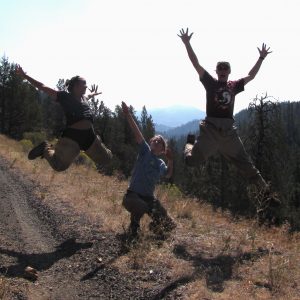
Field Season here on the Modoc is definitely on its way out. Walking out of the Alturas field office one can feel the crisp cold bite of winter on its way. Hiking up Patterson Lake in the South Warner Mountains last weekend was incredibly beautiful. Amidst the dark pines and grasslands groves of Aspens were beginning to turn a golden delicious yellow. One by one other seasonals from all departments are falling away like leaves, returning to school or their next adventures. My partner Joe and I have made so many seed collections this season we have lost count. Among the last ones aquired were Yellow Rabbit Brush, Chrysothamnus viscidiflorus, California Rudbush, Cercis occidentalis var. orbiculata and Mountain Mahogany, Cercocarpus montanus. The latter of which is aptly nicknamed “hell feathers” by cowboys. The Seed hairs can attach to eyes and skin, and CAN cause considerable discomfort. If I ever find myself collecting this unique seed again I will be wearing a hazmat suit! Another collection we made was in a range allotment named Cold Springs. This allotment is in Lassen County, right off of highway 395, in Termo. This particular collection site was at Dodge Springs, a riparian area in the midst of sagebrush habitat which had burned two years ago.

Dodge Springs when we collected seed in early July.

Later on this season Joe and I went back to check up on a couple other plants this is what we found…

Major change!


…Once we arrived back at Dodge Springs it was quite obvious we would not be making any more collections at this site. The vegetation use was vigorous and soil erosion was apparent. There were at least 17 head of cattle “hanging out” in the spring area. We also observed 4 wild horses in the area. When going back to the field office the range supervisor informed us the cows should have been taken out of this area at least three weeks prior. When we went back two weeks later, to check the survival rates of some sagebrush we had planted, the cows were still in the exact same place. One cow had even died — we theorize from getting stuck in the mud. What a drastic impact one season of overgrazing can cause. Once again here is what it looked like two months ago…

Dodge Springs when we collected seed in early July.
According to the BLM Northeastern California Standards for Rangeland Health and Guidelines for Livestock Grazing Management, “Adequate stubble will be present on all stream-side areas at the end of the growing season, or at the end of the grazing season if grazing occurs after fall dormancy. The residual or regrowth should provide sufficient herbaceous forage biomass to meet the requirement of plant vigor maintenance, bank protection, and sediment entrapment” (June 1999). I also read that a 4-6 inch minimum stubble height must remain at the end of the growing season in most riparian areas.
It is clear this is not the case in this riparian area. Possibly this type of heavy use could be improved, with changes in season of use, timing, duration, rotational grazing, herding, fencing, herding and or changes in number of stock. Unfortunately, however, although Dodge spring is surrounded by BLM lands the spring itself is privately owned. As of now the state of California has no rural private landownership standards or guidelines for riparian areas currently in effect.
Thanks to my extension I still get to spend two more months in Alturas and I am looking forward to seeing the first flurries of snow fly on the tablelands.




















